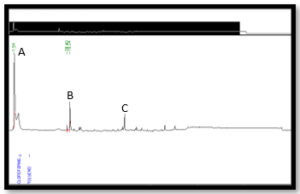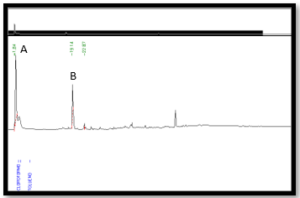Publication Information
Frequency: Continuous
Format: PDF and HTML
Versions: Online (Open Access)
Year first Published: 2019
Language: English
| Journal Menu |
| Editorial Board |
| Reviewer Board |
| Articles |
| Open Access |
| Special Issue Proposals |
| Guidelines for Authors |
| Guidelines for Editors |
| Guidelines for Reviewers |
| Membership |
| Fee and Guidelines |
 |
Insecticide Effect of Ethanolic Extracts of Ambrosia Cumanensis and Argemone Mexicana on Diaphorina Citri.
Miriam Noemí Burgos-Jiménez1, Jacinto Alberto Loeza-Peraza1*, Carolina Lol Be Montejo-Peraza1, Fina Maribel Mex-Be1, Sara Luz Nahuat-Dzib2
1Tecnológico Nacional de México. Instituto Tecnológico Superior del Sur del Estado de Yucatán. Carretera: Akil-Oxkutzcab. Km. 41+100. S/N. C.P. 97880. Oxkutzcab, Yucatán; México. Tel/fax: 01 (997) 9751100/9752184
2Tecnológico Nacional de México. Instituto Tecnológico de Mérida. Km 5. Carretera: Mérida-Progreso. C.P. 97118
Received Date: December 17, 2022; Accepted Date: December 23, 2022; Published Date: December 30, 2022;
*Corresponding author: Jacinto Alberto Loeza-Peraza, Tecnológico Nacional de México. Instituto Tecnológico Superior del Sur del Estado de Yucatán. Carretera: Akil-Oxkutzcab. Km. 41+100. S/N. C.P. 97880. Oxkutzcab, Yucatán; México. Tel/fax: 01 (997) 9751100/9752184. Email: cinjato@gmail.com
Citation: Burgos-Jiménez M N, Loeza-Peraza J A, Montejo-Peraza C L B, Mex-Be F M, Dzib S L N (2022) Insecticide Effect of Ethanolic Extracts of Ambrosia Cumanensis and Argemone Mexicana on Diaphorina Citri. Adv Agri Horti and Ento: AAHE-180.
DOI: 10.37722/AAHAE.2022401
Abstract
Huanglongbing (HLB) is a disease caused by Candidatus Liberibacter and transmitted by the insect Diaphorina citri, which causes substantial annual economic losses for citrus cultivation and trade worldwide. In this research work, ethanolic extracts at concentrations of 5, 10, and 15% of leaves of Ambrosia cumanensis and Argemone mexicana plants were evaluated on the mortality of Diaphorina citri. Mortality rates of 50 to 80% for Ambrosia cumanensis and 70 to 95% for Argemone mexicana were observed; the results were reported after 24 hours of spraying the citrus plants used in the experiments. Mainly components were identified in each sample by high-resolution gas chromatography. The compounds identified for Ambrosia cumanensis were confene, cineole, and cefacetone from highest to lowest concentration, and for the species Argemone mexicana berberine and protopine.
Keywords: Ambrosia cumanensis; Argemone mexicana; Citrus; Diaphorina; mortality
Introduction
The Rutaceae family consists of about 1700 plant species that grow in warm and temperate climates. The most known genus is Citrus, which belongs to the common orange (Citrus sinensis), the Chinese orange (Citrus japonica), the bitter orange (Citrus aurantium), the mandarin (Citrus reticulata), the lemon (Citrus limon), the grapefruit (Citrus paradisi), the lime (Citrus aurantifolia) and the citron (Citrus medica) (Soler, 2006).
World citrus production is 105 million tons per year, more than half of which corresponds to sweet orange (Citrus sinensis), making this fruit the number one crop in the world (Cubero, et al., 2016). Currently, this crop is seriously affected by the appearance of a bacterial disease that has generated substantial economic losses in countries such as the United States, Mexico, and Brazil: Huanglongbing (HLB), or yellow sprout disease, which is one of the most devastating citrus diseases (Badaracco, et al., 2017), with losses of 3 billion dollars in terms of annual production value reported only in Florida (United States) (García-Ruiz, et al., 2013).
The disease is originated by the gram-negative bacterium Candidatus Liberibacter. The main way of dispersal is through two vectors: Diaphorina citri (Kuwayama) for Asian and American species, and Trioza erytreae for the African species (Garcés-Giraldo, 2012). HLB causes mottled leaves and malformed fruit that are unsuitable for the market; affected citrus only manages to live for 5 to 8 years (Bové, 2006).
Chemical control is the most widely technique used for treating HLB, and various insecticides are applied to citrus plantations. However, the massive use of chemical pesticides leads to contamination of the citrus agroecosystem, producing innumerable side effects (Llorens, 2007). Due to the above, it is necessary to find new natural alternatives for the control of HLB, such as plant extracts that have been used since ancient times to control multiple pests. In this research, we evaluated the insecticidal capacity against Diaphorina citri of two wild plant species adapted to the state of Yucatan, as well as determined the principal volatile components that could be associated with insecticidal properties.
Methods
Collection of plant material
The leaves of adult plants of Argemone mexicana (Chicalote) and Ambrosia cumanensis (Artemisia) were collected in the municipality of Oxkutzcab, Yucatán. The leaves were transferred to the Biochemistry laboratory of the Instituto Tecnológico Superior del Sur del Estado de Yucatán, washed with soap and water, and dried in a drying oven at 45 °C for 25 minutes to eliminate free water.
Obtaining extracts
The plant material was cut into small squares of approximately 2 cm2, 90 g of leaves of each species were weighed and macerated separately in porcelain mortars, and 100 mL of 70% ethanol was added to each sample and left to stand for 24 hours. The samples were filtered on Whatman 540 filter paper. The samples were concentrated in a thermos flask at 78 °C to eliminate the solvent.
Collection of Diaphorina citri
The collection of the insects (Diaphorina citri) was conducted in citrus plots in the municipality of Oxkutzcab, Yucatan, from 7:00 am to 8:00 am. A mouth vacuum cleaner was used to gather adult insects that landed on tender shoots and mature leaves of sweet orange (Citrus sinensis) plants.
Determination of the insecticidal effect
The insecticidal effect of extracts of Argemone mexicana and Ambrosia cumanenesis on samples collected from Diaphorina citri was determined. We used concentrations of 5%, 10%, and 15% of each extract and water as solvent. For all the experiments, we used transparent containers. Citrus sinensis plants were introduced into the containers, sprayed with the extracts, and left to stand for 24 h. Twenty Diaphorina citri insects were introduced into each container and were observed after 24 h. For each treatment, a control was used. Each experiment was performed in triplicate.
Gas chromatography
Perkin Elmer Autosystem XL High-Performance Gas Chromatography (HPLC) was used to determine many volatile components of the extracts evaluated. Three µL of each extract was taken and injected through a micro syringe into the equipment containing an HP-5 capillary column (60 m x 0.25 mm internal diameter and 0.25 µm thickness). Nitrogen was used as carrier gas at a constant flow rate of 1 mL/min, at a pressure of 139 kPa, and a linear velocity of 19 cm/s. The initial temperature was 60 °C for 10 min, gradually increasing by 4 °C per minute until reaching 250 °C. Chromatography was performed for two hours.
Results
After 24 hours of spraying the extracts on Citrus sinensis plants, the percentage of insect mortality was determined. The treatment of Ambrosia cumanensis at 10% and 15% obtained higher mortality of insects, being 80%. In the treatments with Argemone mexicana, higher mortality rates were observed; for the 5% concentration, 70% mortality, and for the 10% and 15%, values of 90% and 95%, respectively (Table 1).
Mortality rate (%)
Concentrate of the extracts
5%
C1
10%
C2
15%
C3
Ambrosia cumanensis
50
10
80
10
80
10
Argemone mmexicana
70
5
90
7
95
7
To determine the components causing the insecticidal effect, the extracts were analyzed by CGRA, and the majority components were found.
In the chromatographic analysis of the Artemisia extracts, 3 peaks were observed, corresponding to the majority compounds confene, cineol, and tanacetone (Figure 1). In the extracts of chicalote, berberine and protopine were obtained (Figure 2).

Figure 1: Majority of components in extracts of Artemisia (Ambrosia cumanensis): confene (A), Cineol (B), and tenacetone (C).

Figure 2: Majority of components in extracts of Chicalote (Aregemone mexicana): Berberine (A) and Protopine (B).
Cazares et al., (2014) reported the results of a similar investigation, where ethanolic extracts of leaves of Neem (Azadirachta indica), wild oregano (Lippia graveolens), guava (Psidium guajava), Cleopatra mandarin (Citrus reshni) and garlic (Allium sativum) at dosages of 50 and 500 ppm, on the repellency and mortality of Diaphorina citri, finding higher repellency rates at 48 hours of observation in the garlic extracts at 50 ppm being 87%, and the highest insecticidal effect in the garlic extract resulting in a mortality of 70. 3%. Likewise, in 2013 Sandoval-Reyes, also evaluated the insecticidal effect of neem (Azadirachta indica), common guava (Psidium guajava), thorn apple (Datura stramonium), and chinaberry tree (Melia azedarach) on Diaphorina citri, finding mortality rates of 79% with toloache extracts.
Other research (Orozco-Santos, 2016) has reported the insecticidal effect of Neem oil and garlic on Diaphorina citri nymphs, so they are considered an excellent alternative to replace organophosphate insecticides.
There are studies (Cruz-Rodríguez, 2007) that support that chemical compound such as flavonoids, phenols, tannins, terpenes, and sterols, among others, are found in distinct parts of plants and have insecticidal activity on different insects.
References
- Badaracco A, Redes F, Preussler C, Agostini J (2017). Citrus Huanglongbing in Argentina: detection and phylogenetic studies of Candidatus Liberibacterasiaticus. Australasian Plant Pathology. 46:171-175.
- Bové J (2006). Huanglongbing: a destructive, newly-emerging, century-old disease of citrus. Journal of Plant Pathology. 7-37.
- Cázares-Alonso N, et al. (2014). Evaluación de diferentes extractos vegetales contra el psílido asiático de los cítricos Diaphorina citri (Hemiptera: Liviidae). Revista Colombiana de Entomologia. 40: 67-73.
- Cubero S, Lee W, Aleixos N, Albert F, Blasco J (2016). Automated systems based on machine vision for inspecting citrus fruits from the field to postharvest-a Review. Food and Bioprocess Technology. 9:1623-1639.
- Garcia-Ruiz F, Sankaran S, Maja J M, Lee W S, Rasmussen J, et al. (2013). Comparison of two aerial imaging platforms for identication of Huanglongbing-infected citrus trees. Computers and Electronics in Agriculture, 91:106-115.
- Cruz C, Rodríguez M (2007). Caracterización de la Riqueza Botánica del Pantano de Vargas, Paipa (Boyacá). Informe final de trabajo de investigación. Disponible en Biblioteca INIAG, UPTC-Tunja. 63p.
- Llorens J (2007). Biología de los enemigos naturales de las plagas de cítricos y efectos de los productos fitosanitarios. Dossiers Agraris ICEA Enemics naturals de plagues en diferents cultius a Cataluny. 71p.
- Orozco-Santos M, et al. (2016). Uso de aceites y extractos vegetales para el control de Diaphorina citri Kuwayama en Lima Mexicana en el trópico seco de México. Southwestern Entomologist. 41:1051-1066.
- Sandoval-Reyes F, et al. (2013). Actividad biológica en campo del extracto etanólico de Melia azadarach, Psidium guajava, Datura stramonium, Pipper auritum y Azadirachta indica sobre Diaphorina citri. Revista Latinoamericana de Recursos Naturales. 9:22-29.
- Soler A, Soler G (2006). Cítricos variedades y técnicas de cultivo. Madrid: Mundi-Prensa libros. 52 p.